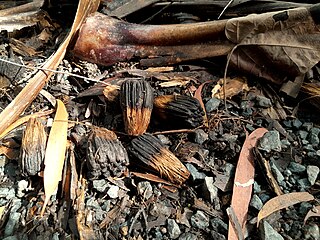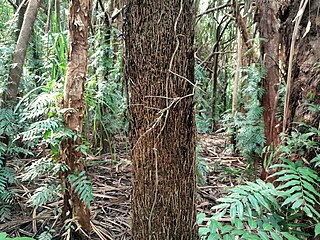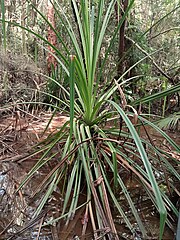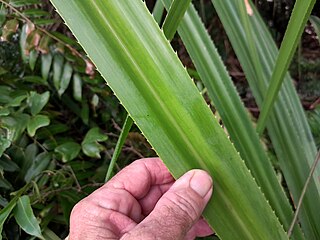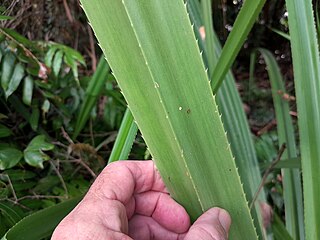Pandanus solms-laubachii
| Swamp pandan | |
|---|---|

| |
| Scientific classification | |
| Kingdom: | Plantae |
| Clade: | Tracheophytes |
| Clade: | Angiosperms |
| Clade: | Monocots |
| Order: | Pandanales |
| Family: | Pandanaceae |
| Genus: | Pandanus |
| Species: | P. solms-laubachii
|
| Binomial name | |
| Pandanus solms-laubachii | |
| Synonyms[4] | |
Pandanus solms-laubachii, commonly known as the swamp pandan, is a small tree in the family Pandanaceae which occurs in northeastern Queensland and possibly in Papua New Guinea. It is closely related to both Pandanus gemmifer and Pandanus grayorum.
Description
[edit]Pandanus solms-laubachii is an evergreen tree usually growing up to about 10 m (33 ft) high, but may reach 20 m (66 ft) on occasions.[5][6] It has an upright trunk around 15 cm (5.9 in) in diameter and an open, widely branching crown. The trunk has numerous warty nodules, which eventually become appressed vertical rootlets on older parts of the stems and branches.[5][6]
The leaves are very long and narrow, arranged in tightly clustered spirals at the ends of the branches. They measure up to 2 m (6 ft 7 in) long and 8 cm (3.1 in) wide, with small ascending spines on the leaf margins and smaller spines on the underside of the midrib.[5][6]
This species is dioecious, meaning that male and female flowers are born on different plants. The inflorescences are terminal and pendant, about 100 cm (39 in) long.[5][6] Female flowers are grouped into segments known as phalanges, each of which contain 10-15 fused flowers.[5][6] There may be up to 125 phalanges per inflorescence.[5][6] The fruit is a syncarp, about 30 by 20 cm (11.8 by 7.9 in), pale orange when ripe with the phalanges conspicuous. At maturity the phalanges are woody and hard.[5][6]
Taxonomy
[edit]Pandanus solms-laubachii was first described in 1887 by the Victorian colonial botanist Ferdinand von Mueller, based on material collected by W. Persich from the Endeavour River on Cape York Peninsula. Mueller's paper describing the species, titled Neuer australischer Pandanus, was published in the journal Botanische Zeitung[7]
Etymology
[edit]The species epithet "solms-laubachii" was created by Mueller in honour of the German botanist Hermann zu Solms-Laubach.[6]
Distribution and habitat
[edit]The swamp pandan is considered to be endemic to Queensland by both Plants of the World Online and Australian Tropical Rainforest Plants,[4][5] but the treatment at Flora of Australia states that it is also found in Papua New Guinea.[6] The Australasian Virtual Herbarium has a single record of this species in Papua New Guinea from 1936.[8] In Australia it occurs from the areas around Mapoon and Lockhart River in Cape York Peninsula, spreading southwards along the east coast to Hinchinbrook Island.[5][6][8]
Within this range the preferred habitat of the species is lowland swamp forests, although it also occurs in gallery forests, rainforests, vine thickets and woodlands, from near sea level up to 500 m (1,600 ft).[5][6]
In the lower reaches of the Mulgrave and Russell rivers, it co-occurs with its close relative Pandanus grayorum.[9]
Ecology
[edit]Pandanus solms-laubachii, along with Pandanus tectorius and Benstonea monticola, is a host plant for the peppermint stick insect (Megacrania batesii), which shelters in the central hollow of the leaves and feeds on them.[10] Red-tailed black cockatoos (Calyptorhynchus banksii) and various native rats are able to gnaw through the hard woody phalanges to access the seeds.[11] The larvae of the banana scab moth (Nacoleia octasema) may attack the fruits of this species.[12][13]
Conservation
[edit]This species is listed by both the Queensland Department of Environment and Science and the International Union for Conservation of Nature (IUCN) as least concern.[1][2] The IUCN provides the following summary as the justification for the classification: "This tree species has a wide distribution and is not currently experiencing any major threats and no significant future threats have been identified. This species is therefore assessed as Least Concern".[2]
Uses
[edit]Like many other species of this genus, the swamp pandan has been used historically for a variety of purposes. The long leaves are easily torn into long strips and used for weaving of baskets, bags, mats, sails, etc,[11] and various other parts of the plant are used for medicines.[12]
Gallery
[edit]-
Growing in swampland near the Cairns Botanic Gardens. March 2023
-
Fruit, with conspicuous phalanges.
-
Old phalanges from the previous fruiting season. Cairns, March 2023
-
Trunk with dense covering of ascending rootlets.
-
Young plant
-
Close up of leaf
-
Close up of leaf, underside
References
[edit]- ^ a b "Species profile—Pandanus solms-laubachii". Queensland Department of Environment and Science. Queensland Government. 2022. Retrieved 27 February 2023.
- ^ a b c IUCN SSC Global Tree Specialist Group; Botanic Gardens Conservation International (BGCI). (2021). "Pandanus solms-laubachii". IUCN Red List of Threatened Species. 2021: e.T192230616A192230618. doi:10.2305/IUCN.UK.2021-1.RLTS.T192230616A192230618.en. Retrieved 27 February 2023.
- ^ "Pandanus solms-laubachii". Australian Plant Name Index (APNI). Centre for Plant Biodiversity Research, Australian Government. Retrieved 27 February 2023.
- ^ a b c "Pandanus solms-laubachii F.Muell". Plants of the World Online. Royal Botanic Gardens, Kew. Retrieved 27 February 2023.
- ^ a b c d e f g h i j F.A.Zich; B.P.M.Hyland; T.Whiffen; R.A.Kerrigan (2020). "Pandanus solmslaubachii". Australian Tropical Rainforest Plants Edition 8 (RFK8). Centre for Australian National Biodiversity Research (CANBR), Australian Government. Retrieved 20 March 2023.
- ^ a b c d e f g h i j k Wilson, A.J.G. (2022). Kodela, P.G. (ed.). "Pandanus solms-laubachii". Flora of Australia. Australian Biological Resources Study, Department of Climate Change, the Environment and Water: Canberra. Retrieved 20 March 2023.
- ^ Mueller, Ferdinand von (1887). "Neuer australischer Pandanus". Botanische Zeitung. 45: 218. Retrieved 20 March 2023.
- ^ a b "Search: species: Pandanus solms-laubachii | Occurrence records | The Australasian Virtual Herbarium". Australasian Virtual Herbarium. Australian Government. Retrieved 21 March 2023.
- ^ "Pandanus grayorum Callm., Buerki & Gallaher, 2021". Plazi.org. Retrieved 21 March 2023.
- ^ Cermak, M.; Hasenpusch, J.W. (2000). "Distribution, biology and conservation status of the peppermint stick insect, Megacrania batesii (Kirby) (Phasmatodea: Phasmatidae), in Queensland". Memoirs of the Queensland Museum. 46 (1): 101–106. ISSN 0079-8835. Retrieved 22 March 2023.
- ^ a b Collis, Tom (September 2022). "Pandanus". Green Space Our Place - Our Volunteers Voice. Cairns: Cairns Regional Council. Retrieved 22 March 2023.
- ^ a b Simpson, Donald. "Pandanus solms-laubachii". Some Magnetic Island Plants. Retrieved 22 March 2023.
- ^ "Banana scab moth". Business Queensland. Queensland Government. 19 October 2022. Retrieved 22 March 2023.
External links
[edit] Data related to Pandanus solms-laubachii at Wikispecies
Data related to Pandanus solms-laubachii at Wikispecies Media related to Pandanus solms-laubachii at Wikimedia Commons
Media related to Pandanus solms-laubachii at Wikimedia Commons- View a map of historical sightings of this species at the Australasian Virtual Herbarium
- View observations of this species on iNaturalist
- View images of this species on Flickriver




